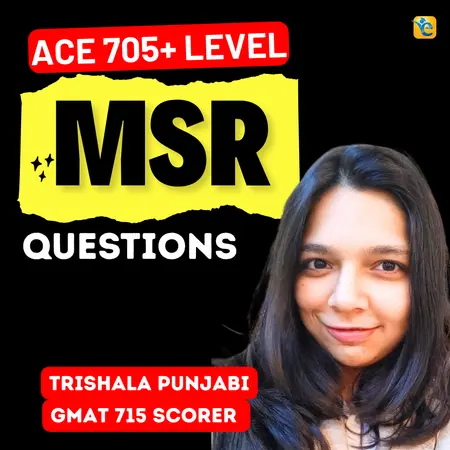Events & Promotions
|
|

GMAT Club Daily Prep
Thank you for using the timer - this advanced tool can estimate your performance and suggest more practice questions. We have subscribed you to Daily Prep Questions via email.
Customized
for You
Track
Your Progress
Practice
Pays
Not interested in getting valuable practice questions and articles delivered to your email? No problem, unsubscribe here.
- Nov 18
11:00 AM PST
-12:00 PM PST
Join us in a live GMAT practice session and solve 30 challenging GMAT questions with other test takers in timed conditions, covering GMAT Quant, Data Sufficiency, Data Insights, Reading Comprehension, and Critical Reasoning questions. - Nov 22
11:00 AM IST
-01:00 PM IST
Do RC/MSR passages scare you? e-GMAT is conducting a masterclass to help you learn – Learn effective reading strategies Tackle difficult RC & MSR with confidence Excel in timed test environment - Nov 23
11:00 AM IST
-01:00 PM IST
Attend this free GMAT Algebra Webinar and learn how to master the most challenging Inequalities and Absolute Value problems with ease. - Nov 25
10:00 AM EST
-11:00 AM EST
Prefer video-based learning? The Target Test Prep OnDemand course is a one-of-a-kind video masterclass featuring 400 hours of lecture-style teaching by Scott Woodbury-Stewart, founder of Target Test Prep and one of the most accomplished GMAT instructors.
E
Be sure to select an answer first to save it in the Error Log before revealing the correct answer (OA)!
Difficulty:
 45%
(medium)
45%
(medium)
Question Stats:
69% (01:51) correct 31%
(02:01)
wrong
31%
(02:01)
wrong  based on 4304
sessions
based on 4304
sessions
History
Date
Time
Result
Not Attempted Yet
In parts of South America, vitamin-A deficiency is a serious health problem, especially among children. In one region, agriculturists hope to improve nutrition by encouraging farmers to plant a new variety of sweet potato called SPK004 that is rich in betacarotene, which the body converts into vitamin A. The plan has good chances of success, since sweet potato is a staple of the region's diet and agriculture, and the varieties currently grown contain little beta-carotene.
Which of the following, if true, most strongly supports the prediction that the plan will succeed?
(A) There are other vegetables currently grown in the region that contain more beta-carotene than the currently cultivated varieties of sweet potato do.
(B) The flesh of SPK004 differs from that of the currently cultivated sweet potatoes in colors and textures, so traditional foods would look somewhat different when prepared from SPK004.
(C) For successful cultivation of SPK004, a soil significantly richer in nitrogen is needed than is needed for the varieties of sweet potato currently cultivated in the region.
(D) There are no other varieties of sweet potato that are significantly richer in beta-carotene than SPK004 is.
(E) The currently cultivated varieties of sweet potato contain no important nutrients that SPK004 lacks.
Similar question from OG: LINK
Which of the following, if true, most strongly supports the prediction that the plan will succeed?
(A) There are other vegetables currently grown in the region that contain more beta-carotene than the currently cultivated varieties of sweet potato do.
(B) The flesh of SPK004 differs from that of the currently cultivated sweet potatoes in colors and textures, so traditional foods would look somewhat different when prepared from SPK004.
(C) For successful cultivation of SPK004, a soil significantly richer in nitrogen is needed than is needed for the varieties of sweet potato currently cultivated in the region.
(D) There are no other varieties of sweet potato that are significantly richer in beta-carotene than SPK004 is.
(E) The currently cultivated varieties of sweet potato contain no important nutrients that SPK004 lacks.
Similar question from OG: LINK
ID: 500268
Kudos
Bookmarks
naruphanp
Hi, there. I'm happy to help with this.
In the prompt:
Sentence #1 frames the situation and states the problem that needs to be resolved --- a vitamin-A deficiency
Sentence #2 presents a plan designed to solve the problem. Th
Sentence #3 present some support for the plan.
The plan's success depends on assumptions, such as:
a) the SPK004 sweet potato will grow successfully there
b) the folks there will be willing to plant & eat the SPK004 sweet potato instead of their traditional sweet potatoes.
c) nutritionally, nothing else would be lost in a switch from traditional sweet potatoes to the SPK004 sweet potato
OK, so we want answer that will strengthen the argument. Often on the GMAT CR, if the question is asking you to strengthen the argument, two or three of the incorrect answers will be weakeners. Conversely, when the CR asks you to weaken the argument, two or three of the incorrect answers will strengthen the argument. Always be on the lookout for incorrect answers that do the opposite of what you were asked to do. Let's look at these answer choices.
A. There are other vegetables currently grown in the region that contain more beta-carotene than the currently cultivated varieties of sweet potato do.
Well, if there are other vegetables currently grown that have more beta-carotene, then it would seem the folks there are already getting enough beta-carotene, and for some reason, they are not properly converting it to vitamin-A. It's unclear what the problem would be, but certainly adding a new sweet potato with more beta-carotene wouldn't necessarily solve anything. The plan will not solve the problem. This answer is a weakener, so it's incorrect.
B. The flesh of SPK004 differs from that of the currently cultivated sweet potatoes in colors and textures, so traditional foods would look somewhat different when prepared from SPK004.
When food is different looking --- especially different in both color and texture --- it can be hard to get folks set in their ways to try it. If a large proportion of the folks in these places either decide not to try the new sweet potato or try it and decide they don't like it, then many people will not eat it and will not get the benefit of the beta-carotene, and thus the vitamin-A deficiency will continue. The plan will not solve the problem. This answer is a weakener, so it's incorrect.
C. For successful cultivation of SPK004, a soil significantly richer in nitrogen is needed than is needed for the varieties of sweet potato currently cultivated in the region.
Hmmm. If the SPK004 sweet potato needs soil much richer in nitrogen, it sounds as if it's at least possible that it won't grow particularly well in these environments. If the farmers there can't grow it well or at all, then it won't replace the traditional sweet potatoes, and no one will benefit. The plan will not solve the problem. This answer is a weakener, so it's incorrect.
D. There are no other varieties of sweet potato that are significantly richer in beta-carotene than SPK004 is.
This is a particularly interesting one. We already can infer that the SPK004 sweet potato has more beta-carotene than the the traditional sweet potatoes in this region. That's the comparison that is meaningful in this argument. This answer choice provides the added information --- the SPK004 sweet potato also contains more beta-carotene than any other variety of sweet potato anywhere else --- China, Uganda, New Zealand, Alabama, etc. Well, that's interesting, but it's not particularly relevant. We already know the important comparison ---- the SPK004 sweet potato vs. sweet potatoes traditionally grown in these parts of South America. That's the part that is pertinent to the argument. The fact that the SPK004 sweet potato also contains more beta-carotene than any other variety of sweet potato in other places --- strictly speaking, this is irrelevant to the argument. Therefore, it is not a strengthener. This answer is incorrect.
E. The currently cultivated varieties of sweet potato contain no important nutrients that SPK004 lacks.
Well, we have just nuked the first four answers, so we hope this one works! Fortunately, this is almost identical to assumption (c) above. So, in switching from the traditional sweet potatoes to the SPK004 sweet potato, these folks will gain beta-carotene and will not lose anything other nutrient. This is a strengthener --- in fact, it's one of the assumptions on which the plan is based.
If we were to deny this and assert the opposite of (E) --- in switching from the traditional sweet potatoes to the SPK004 sweet potato, these folks would beta-carotene but lose some other important nutrient --- then, that would weaken the argument, because it seems like the plan would just replace one problem (a vitamin-A deficiency) with another problem (a deficiency of some other nutrient). Denying (E) weakens the argument, which is further evidence that it's a strengthener.
For all these reasons, (E) is the best answer.
Notice that one strategy that helped significantly in the analysis of this question was finding assumptions before we approached the answer choices. That won't always work, but it works enough that it's a useful strategy. See this post for more on that strategy.
Does all this make sense? Please let me know if you have any further questions.
Mike
Kudos
Bookmarks
crackHSW
GMAT prep sources will talk about types of CR like the "assumption question" and the "strengthen question" in order to elucidate the different possibilities, but do not make the mistake of reifying those differences. On the real GMAT, everything is much more fluid. Knowing how to identify an assumption of an argument is most relevant on an "assumption question", but a choice that affirms an assumption could be a good "strengthener", and a choice that attacked an assumption could be a good weakener. Nothing about the CR on the real GMAT is formulaic, and therefore any rigidity in your approach will be punished. The critical thinking that the CR demands is highly flexible and highly contextual. Learn all the strategies, but don't get locked into the myopic view --- "I can only use this strategy on this question type."
Here's a blog post you may find relevant in this regard
https://magoosh.com/gmat/2012/arguments- ... -the-gmat/
Does all this make sense? Let me know if you have any further questions.
Mike












